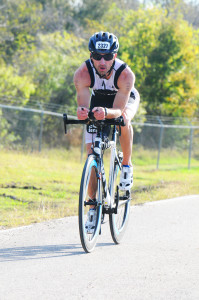For IRONMAN All World Athlete Jason Brown, of Denver, Colorado, there is no time to spare during his 10-month triathlon training period. A full-time school counselor and a top level skier, Brown’s program requires constant efficiency and balance. Though his focus is obviously on long distance training and his sessions never last less than 90 minutes during these 10 months, Jason explains that short high intensity interval training (HIIT) sessions are of equal importance to his program. How does an athlete like Jason Brown, implement HIIT in a long distance triathlon program? …you guessed it TABATA.
Tabata is a 4 minute interval training protocol consisting of 8 intervals. Each interval lasts 20 seconds and is followed by 10 seconds of rest. This Tabata method has been proven to be the most efficient way to train both the aerobic and anaerobic systems. It has been shown to drastically improve a person’s VO2max. Long story short… Tabata works!
“Besides fact that it has been scientifically proven to benefit an athlete’s capacity,” Jason says, “I’m a fan of Tabata training because it is quick, I can do it anywhere, and it is pre-programmed, meaning I don’t really need to put any thought into it. There are a lot of interval methods that are more of a math problem than a workout to me! I listen to Tabata Songs for these workouts, so that I don’t have to look at a timer or even think about how many intervals I have left. Though I love the originals, the Uptown Funk Tabata mix is the current favorite!”
Core Work and Time Crunches
Jason trains his core year-round with an array simple floor exercises. “I’ll usually pick three exercises, pick three Tabata Songs to listen to, and just go all out for 12 minutes. When I’m crunched for time between life and work, I can always carve out 12 minutes before a shower or while out walking the dog. Penny Lane (Jason’s dog) has no problem hanging outside with me while I do a quick workout.”
Sample workout:
Tabata mountain climbers
Tabata Leg raises
Tabata pushups
 Off-Season
Off-Season“Though my off-season is hardly enough time to heal any wear and tear that my body has encountered, it is more than enough time to get completely out of shape! I need to be able to hit the ground running (literally), when I start to train again. Tabata training provides me the ability to train without any emphasis on high milage. I’ll use Tabata on the indoor trainer (stationary indoor bike setup) for a low-impact way of keeping my lung capacity up during the off-season. If I can’t actually finish the eighth interval, I know I’m going hard enough on the first seven… making it a TRUE TABATA!”
Sample workout:
Tabata bike
(Get on a bike, pedal the f*** out of it for 20 seconds at a time!)
Training Season
“During a race, I need to be confident that I can give an extra push during my last quarter mile of the swim, my last 20 miles on the bike, and my final few miles of the run. This confidence can’t come out of thin air, it has to come from experience and conditioning… session upon session of speed work.”
Brown continues to explain his perspective on the importance of speed work in his training. “My goal is of course to finish the race as fast as I possibly can, and to finish each race faster than the last. I have always found that if I want to improve my slowest pace, I need to increase my fastest pace. In other words, if I want to increase my long/slow marathon pace, I need to increase my short/fast pace. This is why every successful training program includes speed work of some kind. Tabata just happens to be my favorite form of speed training, particularly at the end of a session. I find that it improves my recovery time, which is crucial when moving from the swim to the bike and the bike to the run.”
Sample workout:
-Tabata sprints
-Slow 1 mile jog
-Repeat!

